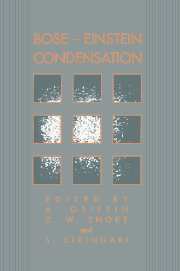Book contents
- Frontmatter
- Contents
- Preface
- Preface to paperback edition
- 1 Introduction: Unifying Themes of Bose–Einstein Condensation
- Part one Review Papers
- 2 Some Comments on Bose–Einstein Condensation
- 3 Bose–Einstein Condensation and Superfluidity
- 4 Bose-Einstein Condensation in Liquid Helium
- 5 Sum Rules and Bose–Einstein Condensation
- 6 Dilute-Degenerate Gases
- 7 Prospects for Bose–Einstein Condensation in Magnetically Trapped Atomic Hydrogen
- 8 Spin-Polarized Hydrogen: Prospects for Bose–Einstein Condensation and Two-Dimensional Superfluidity
- 9 Laser Cooling and Trapping of Neutral Atoms
- 10 Kinetics of Bose–Einstein Condensate Formation in an Interacting Bose Gas
- 11 Condensate Formation in a Bose Gas
- 12 Macroscopic Coherent States of Excitons in Semiconductors
- 13 Bose–Einstein Condensation of a Nearly Ideal Gas: Excitons in Cu2O
- 14 Bose–Einstein Condensation of Excitonic Particles in Semiconductors
- 15 Crossover from BCS Theory to Bose–Einstein Condensation
- 16 Bose–Einstein Condensation of Bipolarons in High-Tc Superconductors
- 17 The Bosonization Method in Nuclear Physics
- 18 Kaon Condensation in Dense Matter
- 19 Broken Gauge Symmetry in a Bose Condensate
- Part two Brief Reports
- Appendix. BEC 93 Participant List
- Index
11 - Condensate Formation in a Bose Gas
Published online by Cambridge University Press: 15 December 2009
- Frontmatter
- Contents
- Preface
- Preface to paperback edition
- 1 Introduction: Unifying Themes of Bose–Einstein Condensation
- Part one Review Papers
- 2 Some Comments on Bose–Einstein Condensation
- 3 Bose–Einstein Condensation and Superfluidity
- 4 Bose-Einstein Condensation in Liquid Helium
- 5 Sum Rules and Bose–Einstein Condensation
- 6 Dilute-Degenerate Gases
- 7 Prospects for Bose–Einstein Condensation in Magnetically Trapped Atomic Hydrogen
- 8 Spin-Polarized Hydrogen: Prospects for Bose–Einstein Condensation and Two-Dimensional Superfluidity
- 9 Laser Cooling and Trapping of Neutral Atoms
- 10 Kinetics of Bose–Einstein Condensate Formation in an Interacting Bose Gas
- 11 Condensate Formation in a Bose Gas
- 12 Macroscopic Coherent States of Excitons in Semiconductors
- 13 Bose–Einstein Condensation of a Nearly Ideal Gas: Excitons in Cu2O
- 14 Bose–Einstein Condensation of Excitonic Particles in Semiconductors
- 15 Crossover from BCS Theory to Bose–Einstein Condensation
- 16 Bose–Einstein Condensation of Bipolarons in High-Tc Superconductors
- 17 The Bosonization Method in Nuclear Physics
- 18 Kaon Condensation in Dense Matter
- 19 Broken Gauge Symmetry in a Bose Condensate
- Part two Brief Reports
- Appendix. BEC 93 Participant List
- Index
Summary
Abstract
Using magnetically trapped atomic hydrogen as an example, we investigate the prospects of achieving Bose–Einstein condensation in a dilute Bose gas. We show that, if the gas is quenched sufficiently far into the critical region of the phase transition, the typical time scale for the nucleation of the condensate density is short and of O(ħ/kBTc). As a result we find that thermalizing elastic collisions act as a bottleneck for the formation of the condensate. In the case of doubly polarized atomic hydrogen these occur much more frequently than the inelastic collisions leading to decay and we are led to the conclusion that Bose–Einstein condensation can indeed be achieved within the lifetime of the gas.
Introduction
In the last few years it has been clearly demonstrated that not only charged ions but also neutral atoms can be conveniently trapped and cooled by means of electro-magnetic fields. Although the physics of the various ingenious scenarios developed to accomplish this is already interesting in itself [1], the opportunities offered by an atomic gas sample at very low temperatures are exciting in their own right. Examples in this respect are the performance of high-precision spectroscopy, the search for a violation of CP invariance by measuring the electric dipole moment of atomic cesium [2], the construction of an improved time standard based on an atomic fountain [3] and the achievement of Bose–Einstein condensation in a weakly interacting gas.
- Type
- Chapter
- Information
- Bose-Einstein Condensation , pp. 226 - 245Publisher: Cambridge University PressPrint publication year: 1995
- 7
- Cited by

